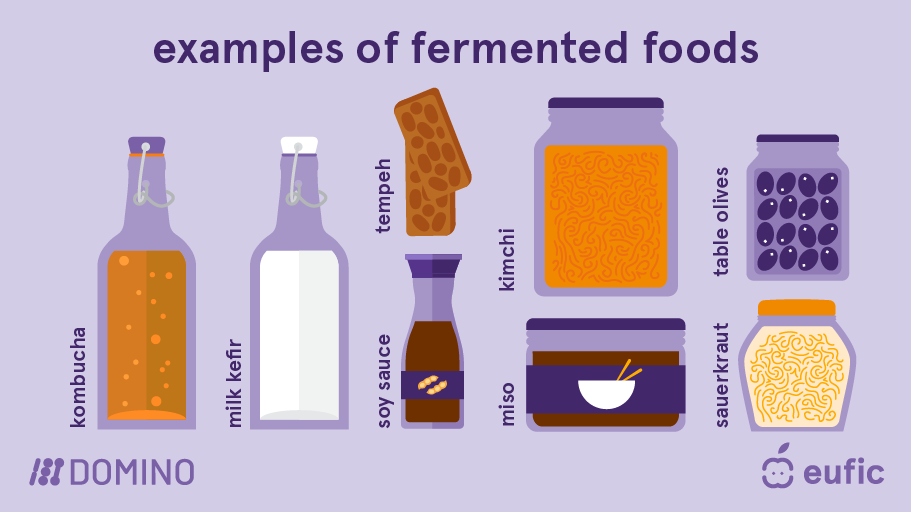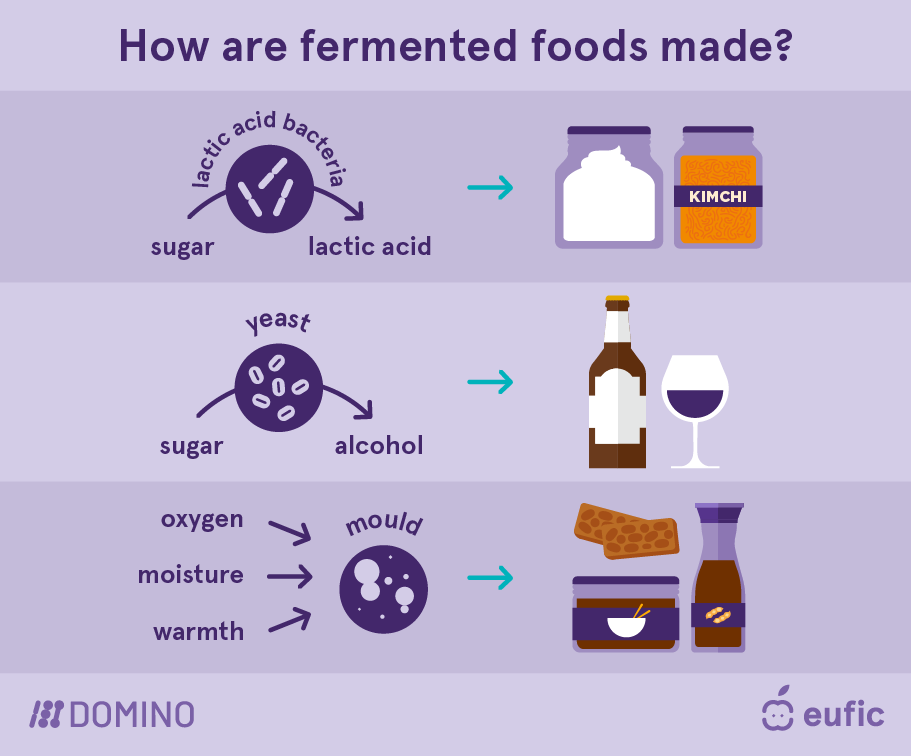What are fermented foods?
Since ancient times, fermented foods and beverages have been part of the human diet, for example in the form of bread, wine, beer and cheese. By definition, fermented foods are “foods and beverages made through desired microbial growth and enzymatic conversions of food components”. In simple terms this means that a food substrate, coming from plants or animals, undergoes controlled microbial growth and fermentation.
Fermentation is a metabolic process in which microorganisms, either naturally present in the food or added, break down complex nutrients present in the food into simpler components. This brings about a desirable change in the taste, texture, digestibility and durability of the food. Today, it is estimated that more than 5,000 varieties of fermented foods and beverages are produced and consumed globally, with characteristic differences from region to region that depend on local traditions, conditions and availability of raw materials.
Historical context
Already about 12,000 years ago, with the transition from hunter-gather communities to sessile agriculture communities, humans have discovered that fermentation provides many important advantages for managing precious food resources. One of the greatest benefits of fermentation is its ability to preserve food, and thus extend its shelf life, minimizing food loss and ensuring food supply even in times of low harvest. This quality, along with the sensory, palatability and nutritional benefits of fermented foods, have led to the inclusion of fermented foods in the diets of nearly every culture in the world and the tradition of fermentation processes has been passed through generations.
The art of cheese making, for instance, was discovered around 8,000 years ago between the Tigris and Euphrates rivers in the area of modern-day Iraq, when milk was stored in the stomach of a ruminant animal by nomads and started to ferment. Later, Egyptian and Sumerian civilizations developed alcoholic fermentations to produce wine and beer and the Egyptians also learned how to make bread rise by using fermentation.

How does food fermentation work?
There are two main ways that food can be fermented. The first way is natural fermentation, or also referred to as “spontaneous fermentation”, where the microorganisms needed for fermentation are already present in the raw food or in the environment where it’s processed. Some examples of foods made this way are sauerkraut, kimchi, and certain types of fermented soy products. The second way is by using starter cultures, which are specific microorganisms added to the food to start the fermentation process. This is called “culture-dependent fermentation”. Some examples of foods made this way are kefir and kombucha.
During the fermentation process, the microorganisms transform macronutrients that are present in the food substrate into simpler and often characteristically unique components (e.g., carbohydrates into alcohols, proteins into peptides). This is done through the work of enzymes whose production is specific to the type of microorganism. Therefore, different species of microorganisms are used to produce different types of food products. The most commonly used microorganisms in food fermentation are lactic acid bacteria, yeast and moulds.

What are the benefits of food fermentation?
Preservation
Fermentation helps in preserving food by creating an acidic or alcoholic environment that inhibits the growth of harmful bacteria and molds. This extends the shelf life of food, allowing it to be stored and consumed for longer periods.
Enhanced Sensory Properties
Fermentation can significantly improve the taste and flavor of food, as the breakdown of complex compounds during fermentation produces various aromatic compounds which give fermented foods their distinct and often desirable flavors. Additionally, fermentation can transform the texture of foods, resulting in desirable qualities such as improved tenderness, creaminess, or crunchiness.
Nutritional Boost
Fermentation can enhance the nutritional value of certain foods. It can increase the bioavailability of certain nutrients, such as vitamins and bioactive compounds, making them easier for our bodies to absorb and utilize.
Digestive Benefits
Fermented foods often contain beneficial bacteria or probiotics that can support gut health. These live microorganisms can help balance the gut microbiota and promote a healthy digestive system.
Detoxification
Some fermentation processes can help reduce the presence of certain toxins or anti-nutrients in food. For example, fermentation can break down phytic acid found in grains and legumes, which can inhibit nutrient absorption.
Environmental Benefits
Fermentation can contribute to reducing food waste, both at the consumer and producer level, in different manners. On the one hand, by extending the shelf-life of foods, fermentation reduces the need to discard expired or spoiled food. Next, it offers a way to use surplus or imperfect produce that might otherwise go to waste, transforming them into valuable and flavorful food products. Last but not least, it can promote a focus on local and seasonal produce, as it allows for the preservation of local produce when it’s abundant and in season, ensuring its supply throughout the year and reducing the need for long-distance transportation.
Cultivation of Microbial Diversity
Fermentation encourages the cultivation of diverse microbial communities. This can have positive implications for biodiversity and ecosystem health, as diverse microbial populations play crucial roles in soil fertility, plant health, and overall ecosystem functioning.